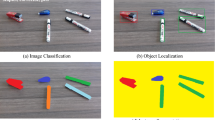Abstract
A spatially variant finite mixture model with Student’s t-distribution component function is proposed for grayscale image segmentation. This model employs a new weight function which contains the information along the different spatial directions indicating the relationship of the pixels in the neighborhood. The label probability proportions are explicitly represented as probability vectors in the model. Gradient descend method is used to update the unknown parameters. The proposed model contains fewer parameters and it is easy to be implemented compare with the Markov random field (MRF) models. Comprehensive experiments on synthetic and natural images are carried out to demonstrate that the proposed model outperforms some other related ones.






Similar content being viewed by others
References
Blekas K, Likas A, Galatsanos N, Lagaris I (2005) A spatially constrained mixture model for image segmentation. IEEE Trans Neural Netw 16:494–498. doi:10.1109/TNN.2004.841773
Bishop C (2006) Pattern recognition and machine learning. Springer, Berlin Heidelberg New York
Carson C, Belongie S, Greenspan H, Malik J (2002) Blobword:image segmentation using expectation-maximization and its application to image querying. IEEE Trans Pattern Anal Mach Intell 24:1026–1038. doi:10.1109/TPAMI.2002.1023800
Chatzis SP, Kosmopoulos DI (2011) A variational Bayesian methodology for hidden Markov models utilizing student’s-t mixtures. Pattern Recogn 44:295–306. doi:10.1016/j.patcog.2010.09.001
Chatzis SP, Kosmopoulos DI, Varvarigou TA (2008) Signal modeling and classification using a robust latent space model based on t distributions. IEEE Trans Signal Process 56:949–963. doi:10.1109/TSP.2007.907912
Chatzis SP, Kosmopoulos DI, Varvarigou TA (2009) Robust sequential data modeling using an outlier to tolerant hidden Markov model. IEEE Trans Pattern Anal Mach Intell 31:1657–1669
Dempster P, Laird NM, Rubin DB (1977) Maximum likelihood from incomplete data via EM algorithm. J R Stat Soc 39:1–38
Forsyth DA, Ponce J (2003) Computer vision: a modern approach. Prentice Hall, Englewood Cliffs
Geman S, Geman D (1984) Stochastic relaxation, Gibbs distributions,and the Bayesian restoration of images. IEEE Trans Pattern Anal Mach Intell 6:721–741
Geusebroek JM, Burghouts GJ, Smeulders AW (2005) The Amsterdam library of object images. Int J Comput Vis 61:103–112. doi:10.1023/B:VISI.0000042993.50813.60
Ismail B, Amar M (2008) A region merging prior for variational level set image segmentation. IEEE Trans Image Process 17:2301–2311. doi:10.1109/TIP.2008.2006425
Jordan MT, Ghabramani Z, Jaakkola TS, Saul LK (1999) An introduction to variational methods for graphical models. Mach Learn 37:183–233. doi:10.1023/A:1007665907178
Li SZ (2009) Markov random field modeling in image analysis. Springer, Berlin Heidelberg New York
Mariano R, Oscar D, Washington M, Alonso R (2012) Spatial sampling for image segmentation. Comput J 55:313–324. doi:10.1093/comjnl/bxr032
Martin D, Fowlkes C, Tal D, Malik J (2001) A database of human segmented natural images and its application to evaluating segmentation algorithms and measuring ecological statistics. In: Proc IEEE conf computer vision (ICCV2001), pp 416–423
McLachlan G, Peel D (2000) Finite mixture models. Wiley, New York
Nikou C, Galatsanos N, Likas A (2007) A class-adaptive spatially variant mixture model for image segmentation. IEEE Trans Image Process 16:1121–1130. doi:10.1109/TIP.2007.891771
Peel D, McLachlan GJ (2000) Robust mixture modelling using the t distribution. Stat Comput 10:335–344. doi:10.1023/A:1008981510081
Ren X, Malik J (2003) Learning a classification model for segmentation. In: Proc IEEE conf computer vision (ICCV2003), pp 10–17
Sanjay GS, Hebert TJ (1998) Bayesian pixel classification using spatially variant finite mixtures and the generalized EM algorithm. IEEE Trans Image Process 7:1014–1028. doi:10.1109/83.701161
Sfikas G, Nikou C, Galatsanos N, Heinrich C (2010) Spatially varying mixtures incorporating line processes for image segmentation. J Math Imaging Vis 36:91–110. doi:10.1007/s10851-009-0174-x
Svensen M, Bishop C (2005) Robust Bayesian mixture modelling. Neurocomputing 64:235–252. doi:10.1016/j.neucom.-2004.11.018
Thanh MN, Wu QM, (2012) Gaussian-mixture-model-based spatial neighborhood relationships for pixel labeling problem. IEEE Trans Syst Man Cybern, Part B, Cybern 42:193–202. doi:10.1109/TSMCB.2011.2161284
Thanh MN, Wu QM, Ahuja S (2010) An extension of the standard mixture model for image segmentation. IEEE Trans Neural Netw 21:1326–1338. doi:10.1109/TNN.2010.2054109
Titterington DM, Smith AFM, Makov UE (1985) Statistical analysis of finite mixture distributions. Wiley, New York
Unnikrishnan R, Pantofaru C, Hebert M (2007) Toward objective evaluation of image segmentation algorithms. IEEE Trans Pattern Anal Mach Intell 29:929–944. doi:10.1109/TPAMI.2007.1046
Woolrich M, Behrens T (2006) Variational Bayes inference of spatial mixture models for segmentation. IEEE Trans Med Imag 25:1380–1391. doi:10.1109/TMI.2006.880682
Woolrich M, Behrens T, Bechkmann C, Smith S (2005) Mixture models with adaptive spatial regularisation for segmentation with an application to FMRI data. IEEE Trans Med Imag 24:1–11. doi:10.1109/TMI.2004.836545
Zhang Y, Brady M, Smith S (2001) Segmentation of brain MR images through a hidden Markov random field model and the expectation maximization algorithm. IEEE Trans Med Imag 20:45–57. doi:10.1109/42.906424
Acknowledgements
The authors would like to thank the anonymous reviewers for their valuable comments and suggestions, which greatly helped to improve both the technical content and the presentation quality of the paper. This work was supported by National Basic Research Program of China (973 Program) under Grant 2011CB302201, and National Nature Science Foundation of China under grant No. 60931160441 and No. 61003042.
Author information
Authors and Affiliations
Corresponding author
Rights and permissions
About this article
Cite this article
Xiong, T., Yi, Z. & Zhang, L. Grayscale image segmentation by spatially variant mixture model with student’s t-distribution. Multimed Tools Appl 72, 167–189 (2014). https://doi.org/10.1007/s11042-012-1336-1
Published:
Issue Date:
DOI: https://doi.org/10.1007/s11042-012-1336-1




